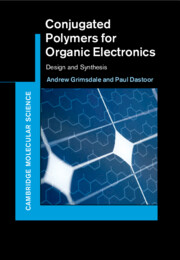Refine search
Actions for selected content:
106069 results in Materials Science
13 - Polymers for Other Luminescent Devices
-
- Book:
- Conjugated Polymers for Organic Electronics
- Published online:
- 28 March 2024
- Print publication:
- 04 April 2024, pp 196-203
-
- Chapter
- Export citation
12 - Polymers for White-Emitting PLEDs
-
- Book:
- Conjugated Polymers for Organic Electronics
- Published online:
- 28 March 2024
- Print publication:
- 04 April 2024, pp 184-195
-
- Chapter
- Export citation
1 - Introduction
-
- Book:
- Conjugated Polymers for Organic Electronics
- Published online:
- 28 March 2024
- Print publication:
- 04 April 2024, pp 1-19
-
- Chapter
- Export citation
4 - Poly(arylene ethynylene)s
-
- Book:
- Conjugated Polymers for Organic Electronics
- Published online:
- 28 March 2024
- Print publication:
- 04 April 2024, pp 54-60
-
- Chapter
- Export citation
Calendar of Forthcoming Meetings: (Occurring after 1 July 2024)
-
- Journal:
- Powder Diffraction / Volume 39 / Issue 2 / June 2024
- Published online by Cambridge University Press:
- 04 April 2024, pp. 115-116
-
- Article
-
- You have access
- HTML
- Export citation
9 - Hyperbranched Polymers, Star Polymers and Dendrimers
-
- Book:
- Conjugated Polymers for Organic Electronics
- Published online:
- 28 March 2024
- Print publication:
- 04 April 2024, pp 149-159
-
- Chapter
- Export citation

Conjugated Polymers for Organic Electronics
- Design and Synthesis
-
- Published online:
- 28 March 2024
- Print publication:
- 04 April 2024
PDJ volume 39 issue 1 Cover and Back matter
-
- Journal:
- Powder Diffraction / Volume 39 / Issue 1 / March 2024
- Published online by Cambridge University Press:
- 25 March 2024, pp. b1-b2
-
- Article
-
- You have access
- Export citation
PDJ volume 39 issue 1 Cover and Front matter
-
- Journal:
- Powder Diffraction / Volume 39 / Issue 1 / March 2024
- Published online by Cambridge University Press:
- 25 March 2024, pp. f1-f3
-
- Article
-
- You have access
- Export citation
Calendar of Forthcoming Meetings
-
- Journal:
- Powder Diffraction / Volume 39 / Issue 1 / March 2024
- Published online by Cambridge University Press:
- 25 March 2024, pp. 37-38
-
- Article
-
- You have access
- HTML
- Export citation
Calendar of Short Courses and Workshops
-
- Journal:
- Powder Diffraction / Volume 39 / Issue 1 / March 2024
- Published online by Cambridge University Press:
- 25 March 2024, p. 39
-
- Article
-
- You have access
- HTML
- Export citation
Crystal structure of nicarbazin, (C13H10N4O5)(C6H8N2O)
-
- Journal:
- Powder Diffraction / Volume 39 / Issue 2 / June 2024
- Published online by Cambridge University Press:
- 18 March 2024, pp. 105-110
-
- Article
-
- You have access
- Open access
- HTML
- Export citation
ICDD ECR Networking Group
-
- Journal:
- Powder Diffraction / Volume 39 / Issue 1 / March 2024
- Published online by Cambridge University Press:
- 06 March 2024, p. 36
-
- Article
- Export citation
Determination of two structures of the solvent 3-hydroxypropionitrile crystallized at low temperatures
-
- Journal:
- Powder Diffraction / Volume 39 / Issue 1 / March 2024
- Published online by Cambridge University Press:
- 01 March 2024, pp. 1-11
-
- Article
- Export citation
Crystal structure of ractopamine hydrochloride, C18H24NO3Cl
-
- Journal:
- Powder Diffraction / Volume 39 / Issue 2 / June 2024
- Published online by Cambridge University Press:
- 29 February 2024, pp. 94-104
-
- Article
-
- You have access
- Open access
- HTML
- Export citation
Simple preparation of specimens for X-ray powder diffraction analysis of radioactive materials: an illustrative example on irradiated granite
-
- Journal:
- Powder Diffraction / Volume 39 / Issue 2 / June 2024
- Published online by Cambridge University Press:
- 29 February 2024, pp. 41-46
-
- Article
-
- You have access
- Open access
- HTML
- Export citation
Crystal structure and synchrotron X-ray powder reference pattern for the porous pillared cyanonickelate, Ni(3-amino-4,4′-bipyridine)[Ni(CN)4]
-
- Journal:
- Powder Diffraction / Volume 39 / Issue 1 / March 2024
- Published online by Cambridge University Press:
- 29 February 2024, pp. 20-28
-
- Article
- Export citation
Proposed crystal structure of carbadox, C11H10N4O4
-
- Journal:
- Powder Diffraction / Volume 39 / Issue 2 / June 2024
- Published online by Cambridge University Press:
- 29 February 2024, pp. 82-93
-
- Article
-
- You have access
- Open access
- HTML
- Export citation
Crystal structure of indacaterol hydrogen maleate (C24H29N2O3)(HC4H2O4)
-
- Journal:
- Powder Diffraction / Volume 39 / Issue 2 / June 2024
- Published online by Cambridge University Press:
- 29 February 2024, pp. 76-81
-
- Article
-
- You have access
- Open access
- HTML
- Export citation
How do we grow a Biodesigner?
-
- Journal:
- Research Directions: Biotechnology Design / Volume 2 / 2024
- Published online by Cambridge University Press:
- 28 February 2024, e2
-
- Article
-
- You have access
- Open access
- HTML
- Export citation

